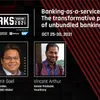Customer engagement, expectation, and excellence: Metrics D2C brands should be chasing
At TechSparks 2021, founders and industry experts delved deeper into India’s booming Direct-to-Consumer (D2C) sector, as more businesses are looking to jump on the bandwagon.
India’s retail boom has a new star — D2C brands. As per data published by Avendus Capital, the D2C sector in the country is estimated to reach a capital of around $100 million by the end of 2025. This growth has been further accelerated by deeper internet penetration, better logistics support, and of course, an increase in the customer base owing to the pandemic.
As India’s D2C sector continues to thrive and grow, brands are focusing on their future growth by redefining their seamless customer experience, leveraging technology.
To discuss this at length, and how the customer-facing brands are keeping up with the expectations, YourStory’s flagship startup-tech conference TechSparks 2021 witnessed a roundtable with industry experts like Tanuj Chowdary, Co-founder and COO, HomeLane; Anand Ayyadurai, Co-founder and CEO, Vogo; Vineet Rao, Founder and CEO, Dealshare; Ajith Mohan Karimpana, Founder, Furlenco; Ankit Garg, Co-founder and CEO, Wakefit.co; Vinay Singh, Co-founder and Partner, Fireside Ventures; and Subramanian Ananthapadmanabhan, Vice President and Head of Midmarket Business, SAP Indian Subcontinent.

All about delivering customer delight
It is important to deliver a customer experience that’s diverse yet unified, according to Vineet, while catering to the mass market. “India is a culturally diverse country, where each locality proclaims uniqueness in their expectations. Thus, innovation catering to a decentralised experience is what we intend to,” he said.
An operationally heavy business, Vogo tries to ensure a seamless customer experience by increasing the number of customers who have perfect rides with their vehicles,” stated Anand.
“Customers are never wrong. So, getting ourselves rectified and not being shouted at on social media is what we aim for,” opined Furlenco’s Ajith. But, that only comes after ensuring the proper delivery of the quality product at the scheduled time.
“The commitment we make to the customers around what the house would look like, added to what the house actually looks like, and the promised timeline are the small delights that we maintain in ensuring a seamless experience,” revealed HomeLane’s Tanuj.
For Wakefit’s Ankit, going beyond expectations is a strong method for strengthening customer experience.
“After engaging them with appealing content, the next step is to ensure a personalised shopping experience, and finally the post-sales delight like helping to track the product, ensuring the correct reviews, sums up the entire journey of seamless customer experience,” added Vinay.
Leveraging technology in the process
“Rather than a product, we thought of ourselves as a platform that would meet the diverse set of customer expectations, and wanted this to be embedded as our core value,” said Vineet. The clock starts ticking right from the point when the customers have acquired knowledge about the product. “We make sure that their in-app experience is a smooth one, that starts right from opening the app, to the ordering of the products, and finally getting them delivered,” he conjectured.
That also brings us to the Keyless technology implemented by Vogo. “Here, a customer locates the scooter that is closest to him, walks up to it, and the vehicle is paired with Bluetooth in the customer’s phone, gets unlocked, and then starts in motion. So, before starting it needs proper authentication of the user,” explained Anand.
How does Wakefit.co scale itself while meeting the infrastructural and technological demands of Tier II, III cities? Sharing a basic matrix followed by the company, Ankit said, “We have massive facilities supporting the infrastructure, which also includes multiple new hirings, and setting up of warehouses.” That would specifically refer to the Data Science team that has been researching the next pincode to set a potential client base.
Next, Ajith detailed the insights behind the world’s first furniture subscription service UNLMTD. Based on the concept that furniture rentals can’t be a way of life, but the subscription can, he added, “The vision was always to make subscription a way of life, and we got inspired by India’s love for the OTT platforms.”
“We just removed the price tag from the furniture and placed it around services. So, it’s like you decide on a price, and you get to choose either a storage bed or a light mattress. We just put a limitation on the number of products,” revealed Ajith while stressing the value for money solutions, and doubling the revenue.
HomeLane set out to solve the large pain points in the home interiors journey using technology. ”We wanted to focus on two major areas — meeting the customers and giving them a basic understanding of what the house would look like, and secondly, the actual cost behind it,” said Tanuj. He also delves deeper into Spacecraft, one of their flagship products, that uses a flop-land for the house, where 1,400 home designers in the platform can turn around a 3D design for the house within 45 minutes. This helps to clarify the design and cost of the house, along with comparisons with competitors.
Busting the myth that SAP is only for large institutions, Subramanian revealed that 80 percent of the business comes from mid-sized companies. “Our deep industry experience insights, combined with business transformation as a service, attracted the early-stage companies also to work with us,” he added. “Besides being a tech-solution partner, we also create a kind of community where our implementation partners and customers can learn together,” he said.
Why investors are bullish about the D2C sector
The pandemic has led to a surge in online shopping, especially with a steep rise of online shoppers from Tier II, III cities. “Investors are excited about the real step jump in digital adoption, and especially on the varied categories of shoppers that are unfolding,” observed Vinay.
Today, horizontal e-commerce has 200 million consumers, while vertical e-commerce is scaling across various categories. Therefore, improved digital infrastructure has given greater access.
But, what does the future look like for India’s D2C sector? “The supply chain is getting efficient, thereby increasing the potentialities of growth for the D2C sector,” said Vineet. While Ajith believed that there would be a hundred more unicorns emerging from the D2C sector, Subramanian added that data science would structure and shape up the entire customer experience journey, and that would be a major deciding factor in the D2C domain.
To log in to our virtual events platform and experience TechSparks 2021 with thousands of other startup-tech enthusiasts from around the world, join here. Don't forget to tag #TechSparks2021 when you share your experience, learnings and favourite moments from TechSparks 2021.
For a line-up of all the action-packed sessions at YourStory's flagship startup-tech conference, check out TechSparks 2021 website.










